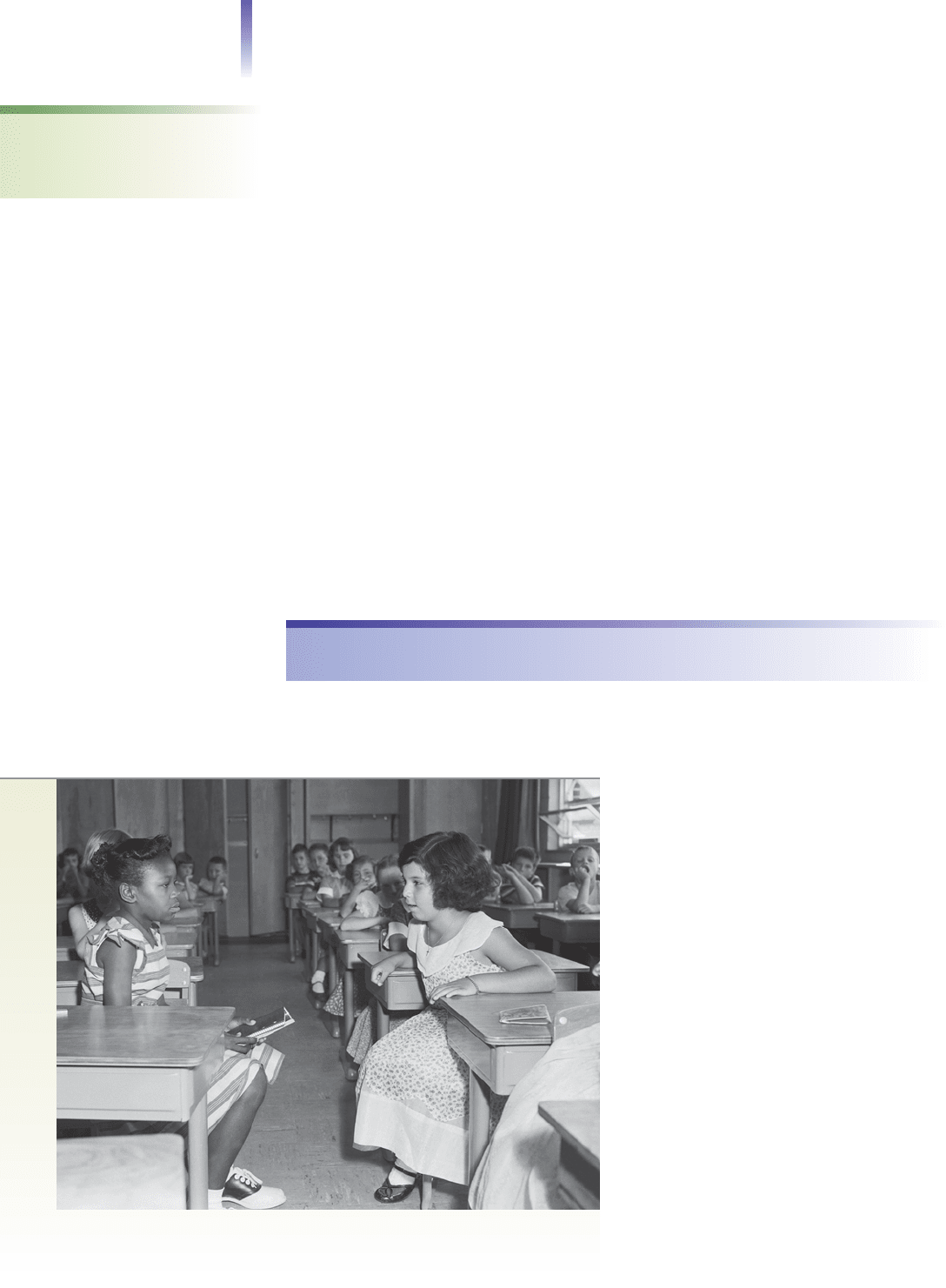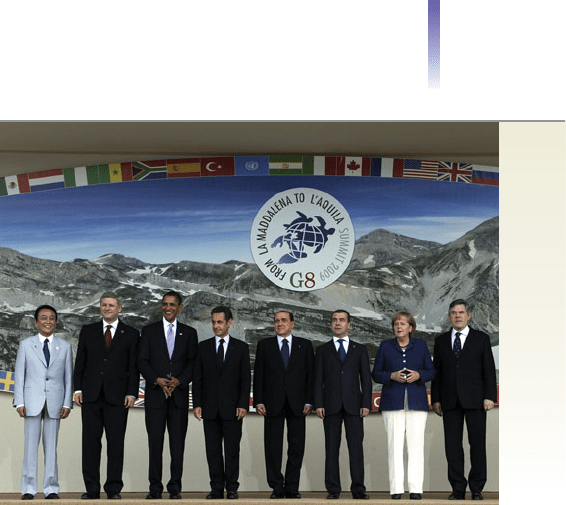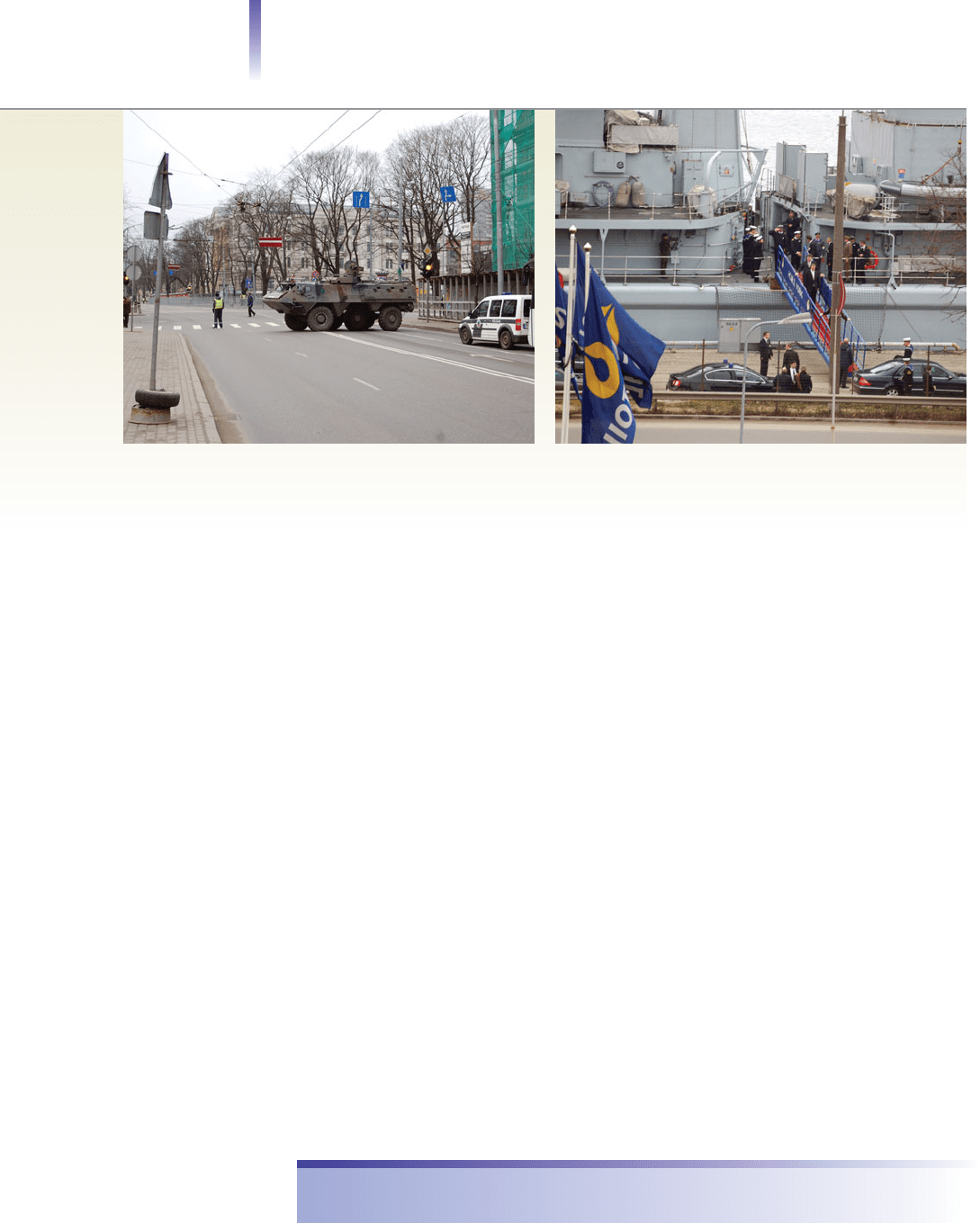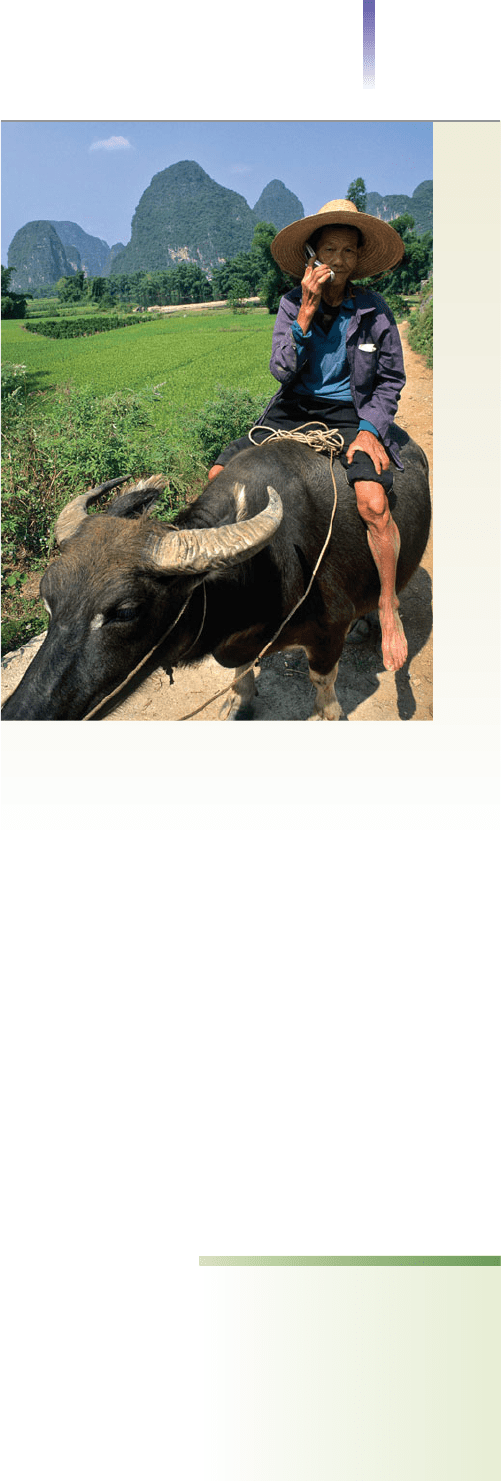Henslin James M. Sociology: A Down to Earth Approach
Подождите немного. Документ загружается.


mong technology’s amazing feats is the
capacity to transplant livers, hearts, and other
organs from one person to another. Because body parts
deteriorate quickly, a surgical team that harvests them is called before
a patient dies. This team is not allowed in the patient’s room be-
fore the death—just to be
sure it doesn’t get impatient
and do something rash. The
team has to wait for another
doctor—who is not a mem-
ber of the team—to declare
the patient dead.
Ruben Navarro, a dis-
abled, brain-damaged 25-year-old, was admitted to Sierra Vista Re-
gional Medical Center in San Luis Obispo, California. Dr. Hootan
Roozrokh, a highly trained surgical specialist was called in, but he
and his team didn’t wait for Navarro to die. After Navarro’s breath-
ing tubes were removed, they entered his room, knives impatient
and ready for Navarro to take his last gasp. Most people die within
a few minutes after their breathing tubes are removed, but Navarro
kept on breathing, while the transplant team grew increasingly im-
patient, knives dangling uselessly at their side.
Dr. Roozrokh ordered that Navarro be given morphine and
Ativan—ten to twenty times the normal dosages. Later he ordered
that Navarro be given Betadine, “a substance that may cause death
if ingested.” When Navarro still hung in there, Roozrokh suggested
that Navarro really was dead, that the electronic monitors were not
showing a heartbeat but, instead, just “pulseless electronic activity.”
Dr. Laura Lubarsky, assigned by the hospital to determine
when Navarro was dead—so that those waiting surgical knives
weren’t put to use prematurely—disagreed. Using a stethoscope, she
said she could hear Navarro’s heart beating.
A slow, agonizing eight hours later, Navarro’s heart finally
gave up.
Finally! But it was too late. You can imagine the disappoint-
ment Dr. Roozrokh felt. Navarro’s death had been so slow that his
organs had deteriorated and were worthless as transplants.
What a wasted day for Roozrokh (for Navarro, too, of course).
But the worst was yet to come for Roozrokh.
After thinking about what happened for a couple of days, a
nurse broke the medical norm against squealing on doctors. The
sheriff investigated, and the district attorney ordered Dr. Roozrokh
arrested. Roozrokh was charged with the felonies of abusing a de-
pendent adult, administering a harmful substance (Betadine), and
They have the nagging feel-
ing that maybe they won’t
really be dead when the
surgeons start to harvest
their organs.
651
A
India

prescribing a controlled substance (morphine) without a legitimate medical purpose. A jury
found Dr. Roozrokh not guilty.
Many people don’t want to sign consent forms to have their organs removed after their
death. Some feel repugnance at the thought of having someone cut up their bodies after they
die. Others have the nagging feeling that maybe they won’t really be dead when the surgeons
start to harvest their organs.
That’s ridiculous. Of course, they’ll be dead. The surgeons will make sure of that.
Or will they? To be sure a heart doesn’t start beating on its own, surgeons have to wait at
least five minutes to remove a heart. “Too long,” said doctors at Denver’s Children’s Hospital,
who decided that they can declare a baby dead without the baby being brain dead. And using a
new technique, they remove the baby’s heart within seventy-five seconds of declaring it dead.
Some physicians are saying, “Not so fast. That baby isn’t really dead!” And they add, “If the
heart can be restarted in another baby, it could have been restarted in the donor baby.”
—Based on Committee on Non-Heart-Beating Transplantation II 2000; Armstrong 2008; Associated Press 2008;
Chawkins 2008; Elsworth 2008; McKinley 2008; Parilla 2008.
If you want a better understanding of society—and your own life—you need to under-
stand social change, probably the main characteristic of social life today. As we shall see
in this chapter, technology, such as that which allows us to transplant human organs from
one person to another, is a driving force behind this change.
How Social Change Transforms Social Life
Social change, a shift in the characteristics of culture and society, is such a vital part of social
life that it has been a recurring theme throughout this book. To make this theme more explicit,
let’s review the main points about social change that we looked at in the preceding chapters.
The Four Social Revolutions
You know that we are in the midst of rapid
social change and that this change is occur-
ring around the world. Why is this happen-
ing? The first thing to understand is that
today’s social change is the result of forces
that were set in motion thousands of years
ago, beginning with the domestication of
plants and animals. This first social revolu-
tion allowed hunting and gathering soci-
eties to develop into horticultural and
pastoral societies (see pages 148–150). The
plow brought about the second social revo-
lution, from which agricultural societies
emerged. The third social revolution,
prompted by the invention of the steam en-
gine, ushered in the Industrial Revolution.
Now we are in the midst of the fourth so-
cial revolution, stimulated by the invention
of the microchip. The process of change has
accelerated so greatly that the mapping of
the human genome system could be push-
ing us into yet another new type of society,
one based on biotechnology.
652 Chapter 22 SOCIAL CHANGE AND THE ENVIRONMENT
Social change comes in many forms. Shown here are students in a Fort Myer, Virginia,
elementary school on the first day of desegregation in 1954. The school, operated by
the military for the children of military personnel, was desegregated by order of the
Defense Department.
social change the alteration
of culture and societies over
time

From
Gemeinschaft
to
Gesellschaft
Although our society has changed extensively—think of how life was for your grandpar-
ents—we have seen only the tip of the iceberg. By the time this fourth—and perhaps
fifth—social revolution is full-blown, little of our current way of life will remain. This as-
sumption is based on what happened in our earlier social revolutions.
Consider the change from agricultural to industrial society. It isn’t just the surface
that changed, such as people living in cities instead of on farms. (See Table 7.1 on page
174.) People’s lives had been built around the reciprocal obligations (such as exchang-
ing favors) that are essential to kinship, social status, and friendship. When people
moved to the city, many intimate relationships were replaced by impersonal associa-
tions built around paid work, contracts, and money. As reviewed on page 106, sociol-
ogists use the terms Gemeinschaft and Gesellschaft to indicate this fundamental shift in
society.
Traditional, or Gemeinschaft, societies are small, rural, and slow-changing. Men dom-
inate social life, and, as has been established for centuries, the divisions of labor between
men and women are rigid. People live in extended families, have little formal education,
treat most illnesses at home, tend to see morals in absolute terms, and consider the past
the key for dealing with the present. In contrast, modern, or Gesellschaft, societies are
large, urbanized, fast-changing, with more fluid divisions of labor between the sexes. In
the third stage of the demographic transition, people have smaller families and low rates
of infant mortality. They prize formal education, are future-oriented, have higher incomes,
and enjoy vastly more material possessions.
The Industrial Revolution and Capitalism
As you can see, these are not just surface
changes. The switch from Gemeinschaft to
Gesellschaft society transformed people’s so-
cial relationships and their orientations to
life. In his analysis of this transition, Karl
Marx stressed that when feudal society
broke up, it threw people off the land, cre-
ating a surplus of labor. When these des-
perate masses moved to cities, they were
exploited by capitalists, the owners of the
means of production (factories, machinery,
tools). This set in motion antagonistic rela-
tionships between capitalists and workers
that remain today.
Max Weber traced capitalism to the
Protestant Reformation (see page 176). He
noted that the Reformation stripped
Protestants of the assurance that church
membership saved them. As they agonized
over heaven and hell, they concluded that
God did not want the elect to live in uncer-
tainty. Surely God would give a sign to as-
sure them that they were predestined to
heaven. That sign, they decided, was pros-
perity. An unexpected consequence of the
Reformation, then, was to make Protes-
tants work hard and be thrifty. This created
an economic surplus, which stimulated
capitalism. In this way, Protestantism laid
the groundwork for the Industrial Revolu-
tion that transformed the world.
How Social Change Transforms Social Life 653
The Protestant Reformation ushered in not only religious change but also, as Max
Weber analyzed, fundamental social-economic change. Before capitalism, only the
nobility and higher clergy could afford such possessions as those shown in this 1533
painting of French ambassadors by Hans Holbein, the Younger.

The sweeping changes ushered in by the Industrial
Revolution, called modernization, are summarized
on Table 22.1. The traits listed on this table are ideal
types in Weber’s sense of the term, for no society exem-
plifies all of them to the maximum degree. Actually,
our new technology has created a remarkable uneven-
ness in the characteristics of nations, making them a
mixture of the traits shown on this table. For example,
Uganda is a traditional society, but the elite have com-
puters, have smaller families, emphasize formal educa-
tion, and so on. Thus the characteristics shown in
Table 22.1 should be interpreted as “more” or “less”
rather than “either-or.”
When technology changes, societies change. Con-
sider how technology from the industrialized world
transforms traditional societies. When the West ex-
ported medicine to the Least Industrialized Na-
tions, for example, death rates dropped while birth
rates remained high. As a result, the population ex-
ploded. It brought hunger, uprooting masses of
people who migrate to cities that have little indus-
trialization to support them. The photo essay on
pages 606–607 and the Cultural Diversity box on
page 616 focus on some of these problems.
Social Movements
Social movements often reveal the cutting edge
of social change. Upset by some aspect of society,
people band together to express their feelings,
even their outrage. They organize to demand
change, or to resist some change they don’t like.
Because social movements form around issues
that bother large numbers of people, they indi-
cate areas of society in which there is great pres-
sure for change. With globalization, these issues
increasingly cut across international boundaries,
indicating areas of discontent and sweeping
change that affect many millions of people in dif-
ferent cultures (see pages 638–648).
Conflict, Power, and Global Politics
In our fast-paced world, we pay most attention to changes that directly affect our own
lives. Mostly out of sight is one of the most significant changes of all, the shifting arrange-
ments of power among nations. By the sixteenth century, global divisions had begun to
emerge. Nations with the most advanced technology (at that time, the swiftest ships and
the most powerful cannons) became wealthy through colonialism, conquering other na-
tions and taking control of their resources. As capitalism emerged, those nations that in-
dustrialized first exploited the resources of countries that had not yet industrialized.
According to world system theory, this made the nonindustrialized nations dependent and
unable to develop their own resources (see pages 252–253).
G7 Plus. Since World War II, a realignment of the world’s powers (called geopolitics)
has resulted in a triadic division of the globe: a Japan-centered East (soon to be domi-
nated by China), a Germany-centered Europe, and a United States–centered western
hemisphere. These three powers, along with four lesser ones—Canada, France, Great
654 Chapter 22 SOCIAL CHANGE AND THE ENVIRONMENT
Characteristics
TABLE 22.1
Comparing Traditional and
Industrialized (and Information) Societies
Source: By the author.
Traditional
Societies
Industrialized
(and Information)
Societies
General Characteristics
Social change Slow Rapid
Size of group Small Large
Religious orientation More Less
Education Informal Formal
Place of residence Rural Urban
Family size Larger Smaller
Infant mortality High Low
Life expectancy Short Long
Health care Home Hospital
Temporal orientation Past Future
Demographic transition First stage Third stage
(or Fourth)
Material Relations
Industrialized No Yes
Technology Simple Complex
Division of labor Simple Complex
Income Low High
Material possessions Few Many
Social Relationships
Basic organization Gemeinschaft Gesellschaft
Families Extended Nuclear
Respect for elders More Less
Social stratification Rigid More open
Statuses More ascribed More achieved
Gender equality Less More
Norms
View of morals Absolute Relativistic
Social control Informal Formal
Tolerance of differences Less More
modernization the transfor-
mation of traditional societies
into industrial societies

Britain, and Italy—formed G7, meaning the “Group of
7.” Fear of Russia’s nuclear arsenal and an attempt to gain
Russia’s cooperation in global affairs prompted G7 to
let Russia join their elite club, forming G8. The
fragility of Russia’s membership, which depends on
its continued cooperation, became apparent with the
armed conflict in Georgia in 2008, as well as with the
snarling and insults member nations have thrown at one
another since then.
No longer can this group ignore the growing wealth and
power of China. Wanting to recapture its glories of cen-
turies past, China is expanding its domain of influence.
Bowing to the inevitable and attempting to reduce the like-
lihood of conflict as China steps on turf claimed by others,
G8 has allowed China to become an observer at its annual
summits. As mentioned in Chapter 11, if China cooperates
adequately, the next step will be to incorporate China into
this exclusive club.
Dividing Up the World. At their annual meetings, these
world powers set policies to guide global economic affairs.
Their goal is to perpetuate their global dominance. Essen-
tial to this goal is trying to maintain access to abundant,
cheap oil—which requires that they dominate the Middle East, not letting it become an
independent power. To the degree that these nations fail to implement policies and inter-
national relations that further their own interests, they undermine the New World Order
they are trying to orchestrate.
Two Threats to This Coalition of Powers. There are two major threats to the global di-
visions that this group is trying to work out. The first is dissension within. Currently,
Russia is at the center of the intrafamilial feuding that threatens this coalition of powers.
Because Russia is still stinging after losing its empire and wants a more powerful presence
on the world stage, it is quick to perceive insult and threat—and to retaliate. In the dead
of winter of 2006 and again in 2008, amidst a dispute with Ukraine over the price of gas,
Russia turned off the oil supply that runs from it through Ukraine to western Europe, en-
dangering lives in several countries (Crossland 2006; Kramer 2009). Russia also threat-
ened to aim its missiles at cities in Europe if the United States didn’t back down from its
plan to put missiles in Poland as part of a missile-defense shield (Blomfield 2007). Rus-
sia even went as far as threatening a nuclear attack on Poland (McElroy 2008). Despite
snarling back and forth, it is likely that these nations will resolve their tensions—including
the coming ones with China—realign their structure of power successfully, and work out
their New World Order.
I was in Riga, Latvia, as Russia’s feud with the other powers began to unfold. While
there, I took the photos on the next page, a foreshadowing of the armed conflict in
Georgia.
The second threat is the resurgence of ethnic rivalries and conflicts. In Europe, ethnic
violence in the former Yugoslavia split the country into seven nations. Ossetians and Geor-
gians recently killed one another, the Flemish say they are not Belgian, and Turks in Ger-
many live in fear of the young Germans who threaten their lives. In Africa, violence erupts
between Kenya’s Kalenjin and Kikuyu, and in Nigeria the Igbo won’t let the government
count them because, as they say, “We are not Nigerian.” Ethnic conflicts threaten the
peace in many parts of the world—from the United States and Mexico in North Amer-
ica to China and Vietnam in Asia. We do not know how long the lid can be kept on these
seemingly bottomless ethnic antagonisms or whether they will ever play themselves out.
For global control, the Most Industrialized Nations require political and economic sta-
bility, both in their own backyards and in those countries that provide the raw materials
essential for their industrial machine. This explains why they care little when African
How Social Change Transforms Social Life 655
Each year, the leaders of the world's eight most powerful
nations meet in a secluded place to make world-controlling
decisions. And each year, protesters demonstrate near the site.
This photo was taken at G8's 2009 meeting at L'Aquila, Italy.

nations self-destruct in ethnic slaughter but refuse to tolerate interethnic warfare in their
own neighborhoods. To let interethnic warfare in Bosnia, Kosovo, or Georgia go
unchecked would be to tolerate conflict that could spread and engulf Europe. In con-
trast, the deaths of hundreds of thousands of Tutsis in Rwanda carried little or no politi-
cal significance for these powerful countries.
The Africa Connections. The Most Industrialized Nations have begun to perceive con-
nections between Africa and their own interests, however, and their attitudes and actions
have begun to change. They are realizing that African poverty and political corruption
breed political unrest. In addition, with political stability, Africa, as the world’s last largely
untapped market, could provide a huge outlet for their underutilized economic machine.
Then, too, there are Africa’s vast mineral resources—and oil reserves that could counter-
balance those of the unstable Middle East. As a result, the United States has raised funds
for African AIDS victims and, as in Liberia, Somalia, and Darfur, has begun to intervene
in African politics.
Information Technology. Just as the development of armaments in the fourteenth and
fifteenth centuries had an impact on global stratification, so, too, today’s information rev-
olution is destined to have similar far-reaching consequences. Those nations that make
the most significant advances in information technology gain tremendous advantage in
the world’s race for dominance. Which nations will do so? The forecast points to an in-
evitable conclusion—the continued global dominance by the Most Industrialized Na-
tions, including China as it joins this group. The fly in the ointment is the development
of nuclear weapons by a state such as Iran or North Korea, which can upset all balances
of power.
Theories and Processes of Social Change
Social change has always fascinated theorists. Earlier in the text, we reviewed the theo-
ries of Karl Marx and Max Weber, which we just summarized. Of the many other at-
tempts to explain why societies change, we shall consider just four: the evolution of
societies, natural cycles, conflict and power, and the pioneering views of sociologist
William Ogburn.
656 Chapter 22 SOCIAL CHANGE AND THE ENVIRONMENT
Armored vehicles blocked streets when NATO held a summit
in Riga, Latvia, in 2006. Disregarding broadcast warnings to stay
off the streets, I wandered around the city, taking photos. I
expected to be stopped, perhaps arrested, but I wasn’t.
Angry that NATO was meeting in Latvia, a country Russia still
claims as its own, Vladimir Putin, then the president of Russia,
boycotted the meetings. I took this photo from an apartment
window overlooking the ship on which NATO held secret
meetings on November 29.

Evolution from Lower to Higher
Evolutionary theories of how societies change are of two types, unilin-
ear and multilinear. Unilinear theories assume that all societies follow
the same path: Each evolves from simpler to more complex forms. This
journey takes each society through uniform sequences (Barnes 1935).
Of the many versions of this theory, the one proposed by Lewis Morgan
(1877) once dominated Western thought. Morgan said that all societies go
through three stages: savagery, barbarism, and civilization. In Morgan’s
eyes, England, his own society, was the epitome of civilization. All other
societies were destined to follow the same path.
Multilinear views of evolution replaced unilinear theories. Instead of
assuming that all societies follow the same sequence, multilinear theorists
proposed that different routes lead to the same stage of development.
Although the paths all lead to industrialization, societies need not pass
through the same sequence of stages on their journey (Sahlins and Ser-
vice 1960; Lenski and Lenski 1987).
Central to all evolutionary theories, whether unilinear or multilinear,
is the assumption of cultural progress. Tribal societies are assumed to have
a primitive form of human culture. As these societies evolve, they will
reach a higher state—the supposedly advanced and superior form that char-
acterizes the Western world. Growing appreciation of the rich diversity—
and complexity—of tribal cultures discredited this idea. In addition,
Western culture is now in crisis (poverty, racism, war, terrorism, sexual as-
saults, unsafe streets) and is no longer regarded as the apex of human civi-
lization. Consequently, the idea of cultural progress has been cast aside, and
evolutionary theories have been rejected (Eder 1990; Smart 1990).
Natural Cycles
Cyclical theories attempt to account for the rise of entire civilizations. Why, for example,
did Egypt, Greece, and Rome wield such power and influence, only to crest and then de-
cline? Cyclical theories assume that civilizations are like organisms: They are born, enjoy
an exuberant youth, come to maturity, and then decline as they reach old age. They finally
die (Hughes 1962).
The cycle does exist, but why? Historian Arnold Toynbee (1946) said that each civi-
lization faces challenges to its existence. Groups work out solutions to these challenges,
as they must be to continue. But those solutions are not satisfactory to all. The ruling
elite manages to keep the remaining oppositional forces under control, even though they
“make trouble” now and then. At a civilization’s peak, however, when it has become an
empire, the ruling elite loses its capacity to keep the masses in line “by charm rather than
by force.” Over time, the fabric of society rips apart. Force may hold the empire together
for hundreds of years, but the civilization is doomed.
In a book that provoked widespread controversy, The Decline of the West (1926–1928),
Oswald Spengler, a high school teacher in Germany, proposed that Western civilization
had passed its peak and was in decline. Although the West succeeded in overcoming the
crises provoked by Hitler and Mussolini, as Toynbee noted, civilizations don’t end in sud-
den collapse. Because the decline can last hundreds of years, perhaps the crisis in West-
ern civilization mentioned earlier (poverty, rape, murder, and so on) indicates that
Spengler was right, and we are now in decline. If so, it appears that China is waiting on
the horizon to be the next global power and to forge a new civilization.
Conflict over Power
Long before Toynbee, Karl Marx identified a recurring process of social change. He said that
each thesis (a current arrangement of power) contains its own antithesis (contradiction or op-
position). A struggle develops between the thesis and its antithesis, leading to a synthesis (a new
arrangement of power). This new social order, in turn, becomes a thesis that will be chal-
lenged by its own antithesis, and so on. Figure 22.1 gives a visual summary of this process.
Theories and Processes of Social Change 657
Despite the globe’s vast social change, people all
over the world continue to make race a fundamental
distinction. Shown here is a Ukrainian being measured
to see if he is really “full lipped” enough to be called
a Tartar.
Source
:
By the author.
Thesis
(some current
arrangement of power)
Synthesis
(a new arrangement
of power)
Antithesis
(contradictions in the
arrangement of power)
Classless state
Process continues
throughout history
FIGURE 22.1
Marx’s Model of
Historical Change

According to Marx’s view (called a dialectical process of history), each ruling group
sows the seeds of its own destruction. Consider capitalism. Marx said that capitalism (the
thesis) is built on the exploitation of workers (an antithesis, or built-in opposition). With
workers and owners on a collision course, the dialectical process will not stop until work-
ers establish a classless state (the synthesis).
The analysis of G7 in the previous section follows conflict theory. G7’s current divi-
sion of the globe’s resources and markets is a thesis. Resentment on the part of have-not
nations is an antithesis. If one of the Least Industrialized Nations gains in military power,
that nation will press for a redistribution of resources. With their nuclear weapons, China,
India, Pakistan, Russia, and, soon, Iran and North Korea fit this scenario. So do the ef-
forts of al-Qaeda to change the balance of power between the Middle East and the indus-
trialized West. Any rearrangement of power (the new synthesis) will contain its own
antitheses. These may be ethnic hostilities, or leaders feeling that their country has been
denied its fair share of resources. These antitheses will haunt the rearrangement of power
and must at some point be resolved into another synthesis. The process repeats.
Ogburn’s Theory
Sociologist William Ogburn (1922/1938, 1961, 1964) proposed a theory of social change
that is based largely on technology. As you can see from Table 22.2, he said that technology
changes society by three processes: invention, discovery, and diffusion. Let’s consider each.
Invention. Ogburn defined invention as a combining of existing elements and ma-
terials to form new ones. We usually think of inventions as being only material items,
such as computers, but there also are social inventions. We have considered many social
inventions in this text including democracy and citizenship (pages 436–437), capital-
ism (pages 174–176, 403–405), socialism (pages 405–406), bureaucracy (pages
176–185), the corporation (pages 187–191, 409–411), and in Chapter 11, gender
equality. We saw how these social inventions had far-reaching consequences on people’s
relationships. Material inventions can also affect social life deeply, and in this chapter
we will examine how the automobile and the computer have transformed society.
Discovery. Ogburn identified discovery, a new way of seeing reality, as a second process
of change. The reality is already present, but people see it for the first time. An example
is Columbus’ “discovery” of North America, which had consequences so huge that they
658 Chapter 22 SOCIAL CHANGE AND THE ENVIRONMENT
Invention Combination of existing 1. Cars 1. Urban sprawl and long
elements to form new ones commutes to work
2. Computers 2. Telework and Global Positioning
System
3. Graphite 3. New types of building
composites construction
Discovery New way of seeing some 1. Columbus—N.America 1. Realignment of global power
aspect of the world 2. Gold in California 2. Westward expansion of
United States
3. DNA 3. Positive identification
of criminals
Diffusion Spread of an invention or 1. Airplanes 1. Global tourism
discovery 2. Money 2. Global trade
3. Condom 3. Smaller families
TABLE 22.2 Ogburn’s Processes of Social Change
Process of Change What It is Examples Social Changes
Source: By the author.
Note: For each example, there are many changes. For some of the changes ushered in by the automobile and computer, see pages 663–670. You can also see that any
particular change, such as global trade, depends not just on one item, but on several preceding changes.
dialectical process (of his-
tory) each arrangement of
power (a thesis) contains con-
tradictions (antitheses) which
make the arrangement unsta-
ble and which must be re-
solved; the new arrangement
of power (a synthesis) contains
its own contradictions; this
process of balancing and unbal-
ancing continues throughout
history as groups struggle for
power and other resources
invention the combination of
existing elements and materials
to form new ones; identified by
William Ogburn as one of three
processes of social change
discovery a new way of see-
ing reality; identified by William
Ogburn as one of three
processes of social change

altered the course of human history. This example also illustrates
another principle: A discovery brings extensive change only when
it comes at the right time. Other groups, such as the Vikings, had
already “discovered” North America in the sense of learning that a
new land existed—obviously no discovery to the Native Ameri-
cans already living in it. Viking settlements disappeared into his-
tory, however, and Norse culture was untouched by the discovery.
Diffusion. Ogburn stressed how diffusion, the spread of an in-
vention or discovery from one area to another, can have extensive
effects on people’s lives. Consider an object as simple as the axe.
When missionaries introduced steel axes to the Aborigines of
Australia, it upset their whole society. Before this, the men con-
trolled axe-making. They used a special stone that was available
only in a remote region, and fathers passed axe-making skills on to
their sons. Women had to request permission to use the axe. When
steel axes became common, women also possessed them, and the
men lost both status and power (Sharp 1995).
Diffusion also includes the spread of social inventions and
ideas. As we saw in Chapter 15, the idea of citizenship changed
political structures around the world. It swept away monarchs as
an unquestioned source of authority. The idea of gender equality
is now circling the globe. To those who are used to this concept,
it is surprising to think that the idea that it is wrong to withhold
rights on the basis of someone’s sex is revolutionary. Like citizen-
ship, gender equality is destined to transform basic human rela-
tionships and entire societies.
Cultural Lag. Ogburn coined the term cultural lag to refer to
how some elements of a culture lag behind the changes that come
from invention, discovery, and diffusion. Technology, he suggested,
usually changes first, with culture lagging behind. In other words,
we play catch-up with changing technology, adapting our customs
and ways of life to meet its needs.
Evaluation of Ogburn’s Theory. Some find Ogburn’s analysis too one-directional, say-
ing that it makes technology the cause of almost all social change. They point out that how
people adapt to technology is only one part of the story. The other part is that people
take control over technology. People develop or adapt the technology they need, and they
selectively use it. You read about the Amish on page 107, a good example, as they reject
technologies they perceive as threatening to their culture.
Think of technology and social change as a two-way street: Just as technology stimu-
lates social change, so social change stimulates technology. Last century, the Nazi armies
marching across Europe stimulated the United States to develop the atomic bomb. Today,
the growing number of elderly is spurring the development of new medical technologies,
such as those used to treat Alzheimer’s disease. Similarly, our changing perspectives about
people with disabilities—that they should not be shunted aside but should participate in
society’s mainstream—has triggered the development of new types of wheelchairs and
prosthetic devices that allow people who cannot move their legs to play basketball,
participate in the Special Olympics, and even compete in rigorous downhill wheelchair
races. The street is so two-way that their greater visibility and participation, in turn, are
changing attitudes toward people with disabilities.
In fairness to Ogburn, we must note that he never said that technology is the only
force for social change. Nor did he assert that people are passive pawns in the face of over-
whelming technological forces. He did stress, though, that the material culture (technol-
ogy) usually changes first, and the symbolic culture (people’s ideas and ways of life)
follows. This direction still holds. As with the organ transplants featured in the chapter’s
Theories and Processes of Social Change 659
Culture contact is the source of diffusion, the spread of an
invention or discovery from one area to another. Shown
here with a camera phone is a farmer in China. A few years
ago, he was cut off from almost everyone except fellow
villagers. How do you think modern communications will
affect his orientation to life?
diffusion the spread of an in-
vention or a discovery from one
area to another; identified by
William Ogburn as one of three
processes of social change
cultural lag Ogburn’s term
for human behavior lagging be-
hind technological innovations

opening vignette, technology underlies the rapid change that is engulfing us today. And
we are still playing catch-up with technology, with the computer especially, which is trans-
forming society and, with it, our way of life.
How Technology Changes Society
As you may recall from Chapter 2, technology has a double meaning. It refers to both the
tools, the items used to accomplish tasks, and the skills or procedures needed to make and
use those tools. Technology refers to tools as simple as a comb and as complicated as a
computer. Technology’s second meaning—the skills or procedures needed to make and
use tools—refers in this case not only to the procedures used to manufacture combs and
computers but also to those that are required to “produce” an acceptable hairdo or to go
online. Apart from its particulars, technology always refers to artificial means of extending
human abilities.
All human groups make and use technology, but the chief characteristic of technology in
postindustrial societies (also called postmodern societies) is that it greatly extends our abil-
ities to communicate, to travel, and to retrieve and analyze information. These new technolo-
gies, as they are called, allow us to do what had never been done before: to transplant organs;
to communicate almost instantaneously anywhere on the globe; to probe space; to travel
greater distances faster; and to store, retrieve, and analyze vast amounts of information.
Change is rapid. Desktop computers are giving way to laptops—and some laptops are
being replaced by handheld devices that contain keyboards and cameras. And this is just the
beginning. In our coming biotech society, we may even “wear” computers, storing data on
holograms located in our own proteins (bacteri-
orhodopsin) (Guessous et al. 2004). Our journey to
the future is going to have so many twists and turns
that no one knows what our life will be like. It is in-
triguing, however, to try to peer over the edge of the
present to catch a glimpse of that future.
The Sociological
Significance of Technology
The sociological significance of technology is how it
changes our way of life. When a technology is in-
troduced into a society, it forces other parts of soci-
ety to give way. In fact, new technologies can reshape
society. Let’s look at four ways that technology
changes social life.
Changes in Social Organization. Technology
changes how people organize themselves. In Chap-
ter 6, we discussed how, before machine technology
was developed, most people worked at home; the
new power-driven machinery required them to leave
their families and go to a place called a factory. In
the first factories, each worker still made an entire
item. Then it was discovered that production in-
creased if each worker performed only a specific
task. One worker would hammer on a single part, or
turn a certain number of bolts, and then someone
else would take the item and do some other repeti-
tive task before a third person took over, and so on.
Henry Ford built on this innovation by developing
660 Chapter 22 SOCIAL CHANGE AND THE ENVIRONMENT
postmodern society an-
other term for postindustrial
society; a chief characteristic is
the use of tools that extend
human abilities to gather and
analyze information, to com-
municate, and to travel
